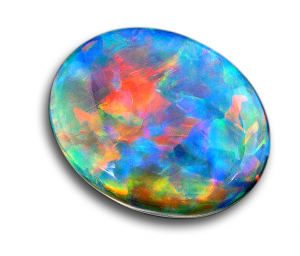Opal is a beautiful, unique gem that derives it’s name from the Latin word “opalus,” meaning ‘precious jewel’. The opal is a non-crystalline mineraloid. It is a form of silica that is found in lumps with intricate and delicate internal displays of color, rather than the norm of externally-ordered crystals. It is this lack of external order that classifies it as a mineraloid, though the clarity afforded by this style of formation allows the internal beauty of the tiny silica spheres arranged in light-catching patterns to show.
non-crystalline mineraloid. It is a form of silica that is found in lumps with intricate and delicate internal displays of color, rather than the norm of externally-ordered crystals. It is this lack of external order that classifies it as a mineraloid, though the clarity afforded by this style of formation allows the internal beauty of the tiny silica spheres arranged in light-catching patterns to show.
What are the varieties of Opal gemstones?
Opal comes in an abundance of varieties which are classified and differentiated by the transparency of the stone as well as the color of the body of the gem. Opals are available in a spectrum of hues which cover all visible colors. The main classifications are known as Common Opal, Crystal Opal, Boulder Opal, Fire Opal and Gem Opal which is then further broken down into subcategories of White (also known as Light) Opal, Black Opal and Opalized Organic Material.
The clear face on an opal allows it’s magnificent internal colors to sparkle through and catch the eye. An opal with opaque patches or inclusions (flaws) will be harder to see into and therefore will attract a lower price. Opals are found in a wide range from transparent to opaque, the former being the most valuable.
what is the best cut for opal gemstone?
A cabochon cut (rounded surface or dome shape with a flat back) is the most common cut for an opal as it allows the most surface area of the mineraloid to be seen into. A well-cut opal is highly valued and cutting is an art. The majority of stones are usually cut free-form as dictated by the opal’s shape and inclusions within the piece. When good-sized opals are cut well they polish up to have a wondrous view into their reflective interiors and they can fetch quite a high price.
where to find the best opal stones?
Opal can form in all mineral environments. Considering that Australia’s mines produce 97% of the world’s supply it is unsurprising that the country holds opal as it’s national gemstone. The town of Coober Peedy in South Australia produces some of the world’s most valuable Black Opal. Boulder Opal is almost completely unique to the state of Queensland, Australia.
Precious opal varieties are also found in North America with the Virgin Valley Opal fields of northern Nevada producing a variety of different types of the jewels.
Other significant deposits can be found in the Czech Republic, Slovakia, Hungary, Turkey, Indonesia, Brazil, Honduras, Guatemala, Nicaragua and Ethiopia.
Most opal is more than 60 million years old and generally dates back to the Cretaceous period when dinosaurs roamed the earth. On the 28th of October in 2008, NASA proclaimed that its Reconnaissance Orbiter discovered opal deposits on Mars!
Characteristics of Opals?
- Specific Gravity: 1.98 – 2.25
- Chemical Composition: SiO2H2O, Hydrous silicon dioxide (water content is usually between 6% to 10%)
- Refractive Index: 1.450 (+.020, -.080)
- Crystal System: Amorphous
- Hardness (Mohs Scale): 4.5 – 6.5 out of 10
Is Opal gemstone treated or enhanced?
Precious Opal is occasionally sealed with resin or wax to improve the shine, increase smoothness, and to protect it from dehydration. Smoking treatments are occasionally done to crystal opals to make them look more like black opals, enhancing the stone’s beauty and value. It is generally these treatments that allow for various price differences that you see online – a point to consider when buying opal jewelry as gifts.
How to spot fake Opal gemstones?
Due to the wide variety of opals available, fakes can be difficult to spot. Look out for completely symmetrical pieces – even with the best cutting and polishing, a true opal will rarely be “perfectly” round. When examined under a strong light, fakes will appear to have color beneath the surface, but not as deeply as a true opal. Additionally, if the price is too good to be true – then it probably is!
